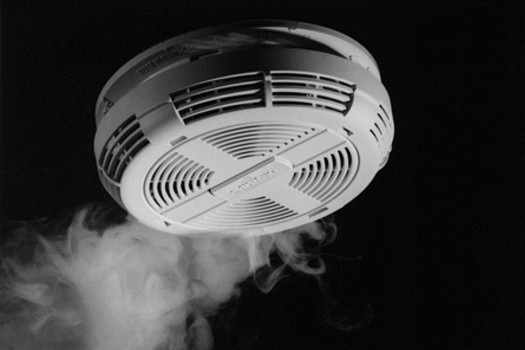
Op-Ed: A Call to Action
We all know the importance of having smoke detectors in our homes, but unfortunately most of us don’t know enough about them. How many times have we heard about smoke detectors having dead batteries? Or no batteries? Or missing entirely?
And so we think that if we put in a new battery when it beeps for one, we’ve done our job and are protected. But are we? I recently investigated the situation and found out something that doesn’t seem to be well known: the sensors in most detectors are unreliable after 10 years from manufacture!
Many new devices actually sound an alert after the 10 year point. Some older ones have an expiration date stamped on the back. Even older ones don’t say anything. This means that there is a good chance that the alarms in your house or apartment may not be properly functional — even if you press the “test” button and it beeps. You see, that test button only tests the electronics and alarm, not the actual sensor. Yes, you could hold a lit candle near it for a while to test the sensor, but the manufacturers advise that if it is over 10 years old it could fail when you need it the most. It’s just not worth risking our families!
Now, if you find, like I did, that your alarms are too old, you must replace them. And even if yours are ok, I’m going to suggest you replace them…
Here’s why: First, it’s an opportunity to add carbon monoxide (CO) detection as well as fire detection, because they now have combined devices. Carbon monoxide is a colorless, odorless gas that can kill. It can be produced by a malfunctioning (or just old) gas-powered furnace, hot water tank, stove, or oven. Your gas stove emits some carbon monoxide when in use. If you leave it on under a blech for Shabbos, there should be a window open in the kitchen. Better still, use an electric hotplate on a timer that shuts it off overnight when no longer needed. And if that hotplate looks old, battered and worn… please replace it!
Second, it’s an opportunity to switch to the newest wireless, interconnected devices. I very highly recommend this option to provide proper protection for your family. The way these work is that if any unit in the house is triggered, it automatically sounds all of the other units. For example if a basement detector triggers a carbon monoxide alert, it would sound the alarm on the unit outside your bedrooms on the second floor. This is so important, because it is unlikely that a beeping alarm two floors below would wake you!
I recently replaced all my detectors. My house is quite large so I put two on each floor. One of each pair is a combined fire and CO detector, the other is just fire. They all interact with each other. Moreover, if one is triggered, they all announce verbally where the triggered alarm is, which helps plan a safe escape route. Knowing that the sensor near the kitchen has detected smoke can be a critical time saver. And in the event of an emergency c”vs, every second counts.
These units are not very expensive (about $35-55 apiece) when one takes into account that they provide safety and security for your family, and that they have a 10 year lifetime. Nonetheless, many large families may have trouble managing to put in the 2, 3 or more units required. And although these are not difficult to set up, they can pose a challenge to the not-so-technically inclined.
One can get help with information about smoke and CO detectors from your local fire department, however they cannot provide the level of support that we would want for our precious families. In my own community, the fire department officials were not even aware that these new wireless interconnected sensors were already commercially available!
I would therefore like to call for the establishment of community organizations to help subsidize the purchase and provide installation of these devices. I would hope that there are enough people of means who will step up and make this happen in their communities. I envision not only a fund that subsidizes the cost for those who need help, but also a small team of volunteers who will plan, install, and/or test the installed system for families. Much like Hatzolah who provide an invaluable service if there is an emergency, why shouldn’t we support the formation of an organization that actually helps prevent emergencies?
One last word… please insist that your children’s small schools and especially dorms upgrade to such a system. (Large institutions often have commercial systems linked to the fire department.) I personally know of a dorm situation where kids were in the basement while a fire was burning on the floor above them. When the detector sensed the fire, it sounded all the alarms in the building (including two in the basement), alerting them to a dangerous situation.













Link
Can you please provide a link (Amazon etc) to the wireless detectors you are referring to?
Thanks!
One more point DUAL SENSOR
There are two kinds of smoke alarms – photoelectric & ionization. Ionization is the typical fire alarm, it detects a fire – fast flaming fire. Photoelectric detects smoke and slow smoldering fires (which is what an electrical fire usually is). They make dual sensor alarms! So either:
1)Buy a photoelectric & carbon monoxide combined plus a separate cheap ionization alarm
2) buy a dual sensor fire alarm and a separate carbon monoxide alarm.
for more info look here: http://www.nfpa.org/safety-information/for-consumers/fire-and-safety-equipment/smoke-alarms/safety-messages-about-smoke-alarms & http://www.nfpa.org/safety-information/for-consumers/fire-and-safety-equipment/smoke-alarms
GREAT!
Great article, advice and plan of action.
Connected to Fire Dept
We have a fire alarm in our home that is connected to the fire dept. We once had a fire while our babysitter was home with our children, while she did take the children safely outside she panicked and didn’t know whether to call the fire dept or not. However, by the time she knocked on the neighbor’s door to get help the fire dept was already there, they quickly put out the fire before it had a chance to spread, thereby saving our home. The whole ordeal took 5 minutes on the clock. We had to get a new oven though.
Parent
… And perhaps a new babysitter?
Escape Plan
It’s not enough to have a fire alarm system. It is vital to have an escape plan. My husband and I were talking last night about what to do if there is a fire g-d forbid. We have 4 little kids under the age of 6 in three different bedrooms all on the second floor. For safety, there are bars on the second floor windows and extremely difficult to climb out. Our smoke detectors work and will wake up our children, but if the steps are blocked, we don’t have a plan to get out! We were discussing options and came up with a plan. That is just as vital as having an alarm system.
Hershel (op-ed)
Absolutely! There are many issues to safety, and an escape plan is vital. So are easy to locate flashlights that work!
no one special
Please list a “fund” name and address to which one can make a contribution.
If not known, a burglar-alarm system can accommodate a smoke detector; maybe a carbon monoxide sensor as well. Have battery powered, as well, for power outage.
Hershel, good idea using sensors in every room, basement and garage.
Keep reminding people.
Hershel (op-ed)
Unfortunately I’m not in a position to organize such a group… I’m just pleading that our various communities should find a way to establish a local organization to help in this manner. I can offer only technical advice…
I live in CH
There is the general rule that batteries should be changed twice a year, and it is recommended to do it when we turn clocks ahead and back.
Hershel (op-ed)
Absolutely. But please remember that even fresh batteries in an old or dirty alarm may not be providing the protection that you expect.
Hershel (op-ed)
Model numbers keep changing as they make improvements, but I found the First Alert ONELINK system to be very good. I personally have these units:
SA511CN2 (Smoke-only, photo-electric sensor)
SCO501B2 (Smoke+CO, also photo-electric)
There are many models in this ONLINK series and they can all communicate with each other.
Models can be a bit confusing because there are so many. Note that some are WIRED units with battery BACKUP. Most will not want these due to the cost of proper installation. I used to have a wired system but with the improvements over the years I replaced them all with these wireless ones.
While ionization sensor units are available, I don’t believe the ONLINK system currently offers any. Since they are designed to sense open flame more than smouldering fires, they are not as popular and trigger falsely more often. As someone earlier pointed out, the most deadly fires are the electrical type which produce lot of smoke — which is why they make mostly the photoelectric type. Obviously one can install a single ionization device as well, but at this point it would not be interconnected with the system.